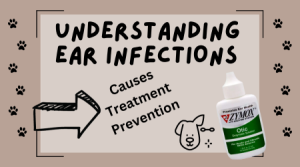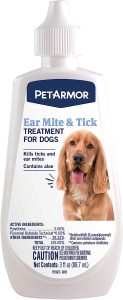
Chronic ear infections can be a sign of allergies or other health issues. Take steps to identify potential causes, consult with your vet for treatment, and employ preventative measures to reduce the risk.
Ear infections are a common ailment in dogs, regardless of breed. Unfortunately, they can be a frequent cause of discomfort and distress to our canine companions. It’s important for responsible pet owners to be informed about the potential causes of ear infections, their treatment, and possible preventative measures that can be taken to avoid them.
Common causes of ear infections include [1]:
- Bacterial and Yeast Infections: Moisture buildup in the ear canal provides an ideal environment for bacteria and yeast to thrive, leading to infections. A bacterial infection can also result if a dog superficially scratches the inside of its ear and it is not noticed or treated promptly.
- Allergies: Dogs, like humans, can be allergic to various environmental factors, including certain foods, which may contribute to ear infections.
- Anatomy and Breed Predisposition: Dogs with floppy ears, such as Cocker Spaniels and Basset Hounds, are more prone to ear infections due to reduced air circulation.
- Foreign Objects: Intrusion of foreign objects, particularly debris/dirt
How do you know if your dog may be suffering from an ear infection? Typically, they will rub or scratch their ears or shake or tilt their heads. There may be an obvious odor around the ears. You may see redness or swelling if you look into the ear canal, or note obvious discharge or wax build up.
It is, of course, recommended that you see your veterinarian if you suspect your dog has an ear infection. Both bacterial and yeast infections can be quickly and effectively treated with medication. Other treatments can be applied, depending on the underlying cause of the infection.[2]
Certainly, preventative measures can improve your puppy’s chances of not developing an ear infection at all. A well-balanced diet, and supplementation if needed, can keep your dog’s immune system strong against any infection (ear or otherwise). Regular ear cleaning is recommended, which will remove excess wax and debris and cleanse any minor scratches. It is also important to make sure that the ear canal is entirely dry after bathing or swimming. [3] If allergies are a contributing factor to ear infections, your vet may recommend measures to alleviate reactions.
Many Golden Mountain Doodle owners (especially those with curly-coated dogs) prefer to pull the hair out of their dogs’ ears as a preventative measure, to aid in keeping the ear canal clean. The practice of “ear plucking” is often done by groomers and recommended by vets. The opinions on this are, however, somewhat divided. [4]
Some dogs suffer from ear mites (this is more common in puppies than in adult dogs). Symptoms may be similar to those of an ear infection. As well, continual scratching of ear mites could lead to a secondary infection. [5]
By understanding the causes and recognizing the symptoms of ear infections in dogs, you can take proactive steps to maintain your pet’s aural health. Because there are so many potential causes of ear infections, it is important to consult with your veterinarian to determine the best course of treatment. Once an infection clears, take measures to keep ears healthy and prevent recurrence.
Here are links to some recommended products that can help you proactively reduce the likelihood of your GMD developing an ear infection (these are affiliate links):
[1] https://www.akc.org/expert-advice/health/dog-ear-infections/
[2] https://www.petmd.com/dog/conditions/dog-ear-infections
[3] https://www.akc.org/expert-advice/health/tips-preventing-ear-infections/
[4] http://www.cahillanimalhospital.co.nz/dermatology-hairy-ears–to-pluck-or-not-to-pluck.html
[5] https://www.petmd.com/dog/conditions/infectious-parasitic/ear-mites-dogs








